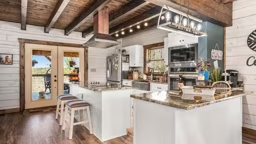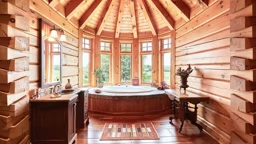
Photos: Mark Sorenson; Home by Estemerwalt Log Homes
If you think “love” and “laundry” don’t belong in the same sentence, here’s something to think about: When you build a home, you have the opportunity to make every space one that you’ll love — including the laundry room.
As one of the hardest working zones in your home, the laundry room is all too often a floor plan afterthought. That leads to a space that neither functions well nor looks particularly appealing. And, while it’s a given that when you’re in the laundry room, you’re taking care of chores, that doesn’t mean being in the space should be drudgery. If you have to spend time in your laundry room, why not make it an experience you enjoy?
Follow the tips below on placement, design and overall style of your laundry room to take a load off of, well, doing a load.

1. Pick a Place
As a regularly used space in your home, laundry room placement matters. The three common locations are near main living spaces, beside the bedrooms or in an out-of-the-way spot like the basement.
To know which locale is best for you, think through your daily rhythms. Do you do laundry throughout the day while you’re tending to other things in the main living area of the house? Is it a morning ritual or do you tackle it in the evenings when you’ve retired to your bedroom? Perhaps it’s a weekly chore that makes a lesser-visited area, like the basement, a logical choice.
Near the Main Living Area:
Keeping the laundry room centrally located can offer convenient access during the day. Throwing in a load of dish towels is no problem when the washer is just around the corner from the kitchen, say, in the mudroom. If you choose this option, consider whether you are comfortable with guests entering and exiting your home here, possibly being privy to piles of laundry waiting to be done. If you’re not, consider an alternate location. Also, for mudroom placement, know that laundry rooms create considerable amounts of humidity and dust, which may compromise how pleasant it is to enter or exit your home through the area. While a common laundry room location is near the kitchen, this efficient-at-first-glance option may be less appealing with some thought. (Do you really want to handle both dirty and clean clothes near a food-prep area with its accompanying odors and grease?)Near the Master Suite:
Locating the laundry room near bedrooms — the source of most dirty clothes and the repository of clean ones — makes sense. If you have a master on the main, a mudroom-area placement may still make sense, but there are other options. It’s becoming popular, especially among empty-nesters, to place the washer and dryer in the master suite itself, often between the bathroom and walk-in closet. If your bedrooms, including the master, are located on the second story, placing your laundry there, too, will save multiple trips up and down the stairs. But keep in mind that while placement near sleeping spaces will save you steps, noise may be an issue. The spin-cycle of a washing machine or the hum of the dryer may be a disruption to light sleepers. If placing a laundry facility in a hallway, consider measures to stifle the sounds.In the Basement:
Depending on your daily habits, “out of sight, out of mind” may or may not be a good thing if your laundry is located in the basement. For those who look at it as a weekly chore, hiding it down below may present minimal inconvenience; however, someone who washes and dries a load per day could find this arrangement frustrating. Another consideration: This location may create access hurdles in the future. Carrying baskets full of laundry up and down stairs could become physically challenging, especially if you’re building your forever home.
2. Design It Right
In laundry room design, as with any area of your home, the goal is to fulfill the room’s purpose without wasting square footage. When laying out the space, consider the dimensions of the appliances that will be housed here. You don’t want to settle on a room size, only to realize your side-by-side washer/dryer won’t fit and that you need to purchase new vertically stacking models. As a rule of thumb, the minimum size for a laundry room is about 9-by-11 feet. Of course, bigger is better. And, if you choose to locate your laundry room in a space with foot traffic, such as a mudroom, allow plenty of floor space to prevent you and your guests from tripping over hampers.
Next, think through each task tackled here — like sorting, washing, drying and folding — as well as any storage space you may need. Mentally make note of each step of the process and create a logical work flow with thoughtful arrangement of appliances and work surfaces. The goal is to maximize accessibility and efficiency. Include space for a bar or rack for hanging clothes fresh from the dryer or more delicate items you prefer to air-dry, a folding counter and room for a built-in or stand-alone ironing board. Decide whether you’ll stash laundry supplies and other household utility items on open shelving or inside cabinets. If space allows, a sink for hand-washing items or pre-treating stains can come in handy, too.
When planning the plumbing, keep hot and cold water valves visible and accessible behind the washer for safety. On a related note, when it comes to flooring, tile or natural stone floors are viable options, as long as you install a waterproof membrane under the floor. Whatever material you choose, floors should have a gentle slope towards the drain in the center of the room.
Finally, if space allows, consider expanding your laundry room into a multi-purpose space that is used for more than just caring for clothes. From a pet-washing station to a sewing space to a crafting, gift wrapping or potting area — anything goes.

3. Make It Pretty
Though the laundry room is a utilitarian space revolving around less-than-thrilling tasks, that doesn’t mean it shouldn’t feel welcoming. It will be much more pleasant to tackle the chore if the room makes you happy, so make decor selections that give the space a style you love! Play with patterns by adding a bold floor tile, a cheery wallpaper or backsplash or a fun paint color for any non-log walls.
Also, ditch “laundry room doom and gloom” with a pretty overhead light fixture that adds a dose of style. (If additional task lighting is needed, under-cabinet LEDs do a great job of illuminating work spaces.)
Include accents, like unique cabinet pulls, themed artwork that nod to the room’s purpose and pretty baskets for storing supplies. But, above all, remember “function comes first.” The form (or final look) of the laundry room matters, but it shouldn’t be the deciding factor in its design.











